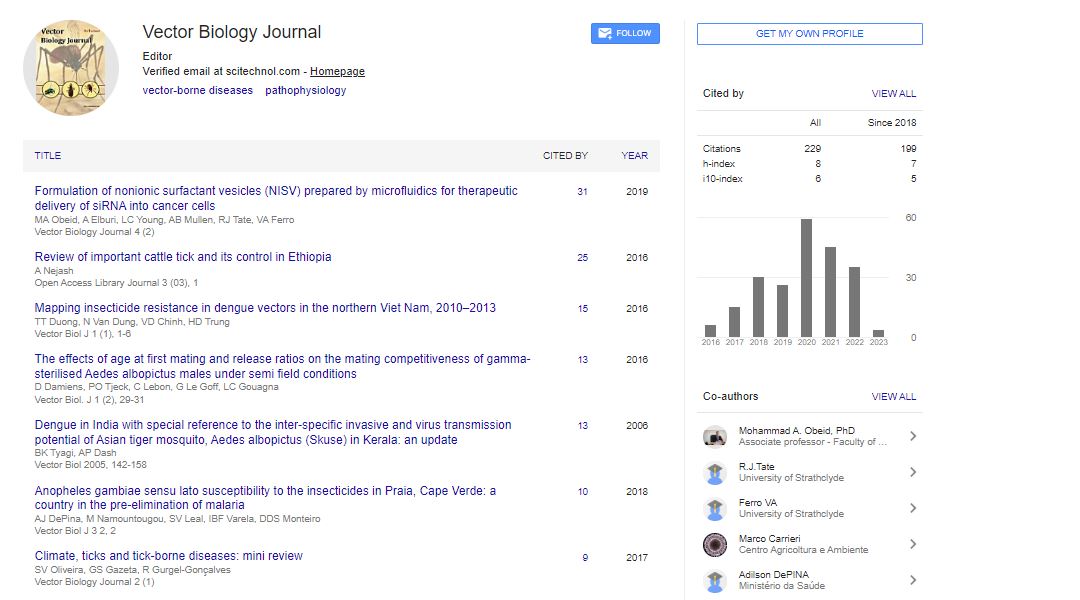Opinion Article, Vector Biol Vol: 8 Issue: 2
An Overview on Sleeping Sickness: Challenges and Future Directions
Arnol Zebaze*
1Department of Biochemistry, University of Dschang, Dschang, Cameroon
*Corresponding Author: Adamantia Arnol Zebaze,
Department of Biochemistry, University of
Dschang, Dschang, Cameroon
E-mail: zebazear_nol@edu.cr
Received date: 30 May, 2023, Manuscript No. VBJ-23-107340;
Editor assigned date: 02 June, 2023, PreQC No. VBJ-23-107340 (PQ);
Reviewed date: 16 June, 2023, QC No. VBJ-23-107340;
Revised date: 23 July, 2023, Manuscript No. VBJ-23-107340 (R);
Published date: 30 June, 2023 DOI: 10.4172/2473-4810.1000266.
Citation: Zebaze A (2023) An Overview on Sleeping Sickness: Challenges and Future Directions. Vector Biol 8:2.
Description
Sleeping sickness, also known as Human African Trypanosomiasis (HAT), is a neglected tropical disease caused by the parasites Trypanosoma brucei gambiense and Trypanosoma brucei rhodesiense. This manuscript provides an overview of sleeping sickness, including its transmission, clinical manifestations, diagnosis, treatment, and control strategies. Despite recent progress in combating the disease, sleeping sickness remains a significant public health concern in certain regions of sub-Saharan Africa. Enhanced efforts in surveillance, diagnosis, treatment, and prevention are required to eliminate this devastating disease.
Sleeping sickness, or human African trypanosomiasis, is a vectorborne parasitic disease that affects humans and animals in sub-Saharan Africa. It is caused by two subspecies of the parasite Trypanosoma brucei: T. b. gambiense and T. b. rhodesiense. This manuscript aims to provide an in-depth understanding of sleeping sickness, highlighting its impact on public health.
The transmission of sleeping sickness occurs through the bite of infected tsetse flies (Glossina species). These flies are prevalent in rural areas of sub-Saharan Africa and are primarily found near rivers and lakes. The parasites multiply in the bloodstream and lymphatic system, leading to systemic infection. Clinical manifestations sleeping sickness progresses in two stages: the early or hemolymphatic stage and the late or meningoencephalitic stage. In the early stage, symptoms include fever, headache, joint pain, and itching. As the disease progresses to the late stage, parasites invade the central nervous system, leading to sleep disturbances, neurological disorders, and ultimately coma and death if left untreated.
Diagnosing sleeping sickness can be challenging due to its nonspecific symptoms and the limited availability of diagnostic tools in resource-limited settings. A combination of clinical assessment, examination of blood or cerebrospinal fluid samples, and serological tests are used to confirm the presence of the parasite and determine the stage of the disease.
Treatment options for sleeping sickness depend on the stage of the disease and the parasite subspecies. Drugs such as pentamidine and suramin are used for the early stage, while eflornithine and melarsoprol are used for the late stage. However, these treatments are associated with significant side effects and require careful monitoring.
Control and prevention efforts to control sleeping sickness focus on vector control, disease surveillance, and case management. Integrated vector control strategies include the use of insecticide-treated traps, insecticide-treated targets, and tsetse fly eradication campaigns. Active case detection, early treatment, and improved access to healthcare facilities are crucial for reducing disease burden.
Challenges and future directions despite progress in the fight against sleeping sickness, several challenges remain. Limited access to healthcare, poor surveillance systems, drug resistance, and inadequate funding hinder effective control and elimination efforts. Strengthening healthcare infrastructure, increasing research and development for new drugs and diagnostics, and enhancing collaboration among stakeholders are necessary to overcome these challenges.
Sleeping sickness continues to be a major public health concern in sub-Saharan Africa, particularly in rural areas with limited resources. Effective control and elimination strategies require a comprehensive approach that includes vector control, improved diagnostic methods, safer and more accessible treatment options, and increased investment in research and healthcare infrastructure. By addressing these challenges, we can work towards the ultimate goal of eliminating sleeping sickness and improving the lives of millions affected by this devastating disease.
 Spanish
Spanish  Chinese
Chinese  Russian
Russian  German
German  French
French  Japanese
Japanese  Portuguese
Portuguese  Hindi
Hindi 